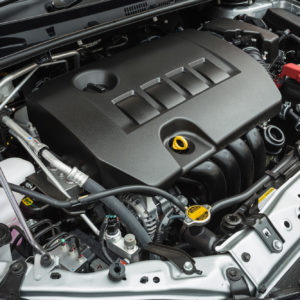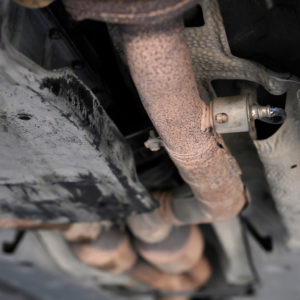The oxygen (O2) sensor measures the oxygen content in the exhaust stream. It also sends rich and lean signals to the powertrain control module (PCM) so that the engine computer can fine-tune the air-fuel mixture during its closed-loop operation.
If the upstream O2 sensor (red arrow) notices that the air-fuel mixture is too rich, it will send a signal to the PCM, and on-board (OBD) diagnostics will log a P0175 code.
What Does the P0175 Code Mean?

Diagnostic trouble code (DTC) P0175 stands for “Engine Too Rich (Bank 2).”
This code usually applies to V6 or V8 engines because they have two banks compared to four-cylinder engines that only have one.
When this code is set, the PCM can no longer adjust the air-fuel mixture automatically.
A rich air-fuel mixture means the exhaust contains very little oxygen, causing the PCM to reduce fuel delivery. The scan tool datastream will show this as negative long term fuel trim.
It should be noted that the oxygen sensor is designed to sense oxygen, not fuel. Whenever any cylinder misfires due to spark or compression, the unburned fuel in the exhaust stream and the oxygen that didn’t unite with that fuel will both pass the O2 sensor. However, all the sensor will see is the oxygen. What that means is that raw fuel from a misfiring cylinder won’t be detected for that reason. But on a misfiring cylinder, most modern ECM/PCMs will kill the injector on that cylinder to prevent damage to the catalytic converter.
Whenever any cylinder misfires due to spark or compression, the unburned fuel in the exhaust stream and the oxygen that didn’t unite with that fuel will both pass the O2 sensor.
– Richard McCuistian, ASE Certified Master Automobile Technician
If the fuel mixture becomes “too rich,” this means that the fuel trim is ranging anywhere between -15 to -30%.
The O2 sensor isn’t a usual suspect for this kind of issue because the PCM validates its readings before logging a code. If the O2 sensor passes its test and the air-fuel mixture is still too rich, the PCM will log a P0175 code.
Note: The definition of code P0175 may be different depending on the vehicle manufacturer. Consult the appropriate repair manual or repair database for the exact code definition.
What are the Common Causes of the P0175 Code?
- Outdated PCM software
- Over reporting MAP sensor
- Stuck fuel pressure regulator
- Faulty coolant/air temperature sensor
- Stuck thermostat or throttle position sensor
- Shorted fuel injector windings
- Faulty air flow meter/sensor
- Faulty O2 sensor
What are the Common Symptoms of the P0175 Code?
- Illuminated check engine light
- Poor acceleration
- Engine misfire
- Rough idling

How to Diagnose the P0175 Code
P0175 is a generic powertrain code that can be logged from one vehicle to another. However, keep in mind that the steps for diagnosis and repair can vary, depending on make-model specifications.
Diagnosing this trouble code typically requires a few tools and conducting a thorough visual inspection of the affected system. If you’re not familiar with diagnosing trouble codes, it’s best to bring your vehicle to the nearest repair shop and have a trusted professional check it for you instead.
But if you’ve had some experience in dealing with DTCs before, then you can go ahead and do it yourself.
How to Fix the P0175 Code
Code P0175 is a generic code that various makes and models can log, so there’s no singular, universal fix for it.
The processes required to repair your vehicle may vary depending on its make and model. For example, the repair procedures for a P0175 code in a Chevy may differ from those needed for a P0175 in a Ford.
With this in mind, if you’re unfamiliar with the processes required to fix a code P0175 error, you have two options.
Bring Your Vehicle to a Professional
If you don’t trust yourself to carry out repairs, consider bringing your vehicle to a licensed mechanic. You’ll spend more money this way than doing it yourself, but you can rest assured that the trouble code will be resolved.
Because you’re paying for both the replacement input/turbine speed sensor and the labor cost, getting a professional to carry out repairs could cost you a lot of money. Expect to spend around $100 to $300 for a complete fix.
Fix the P0175 Code Yourself
Because there’s no universal catch-all fix for the P0175 code, you might need to try different fixes to ensure your turbine speed sensor will work without any issues.
There are two primary fixes worth trying. The first is to replace the turbine speed sensor of your vehicle entirely, and the second is to replace the torque converter.
Replace the Input/Turbine Speed Sensor
Here are the steps to replace the turbine speed sensor.
- Park your vehicle on a flat surface far from other vehicles.
- Disconnect the battery.
- Remove the transmission shield protecting your turbine speed sensor.
- Locate your turbine speed sensor (it’s usually beside the bell housing).
- Unscrew and remove the bolt securing the turbine speed sensor.
- Disconnect the harness and connect your replacement sensor.
- Insert the turbine speed sensor and secure it to your vehicle.
- Reinstall the transmission shield and reconnect the battery.
- Give your vehicle a test drive.
Replace the Torque Converter
If you want to replace your vehicle’s torque converter, follow these steps.
- Park your vehicle on a flat, even surface.
- Lift your vehicle using four jack stands, all kept at the same height.
- Access the drive shaft under the vehicle and remove the U-bolts from the yoke.
- Put your vehicle in neutral and separate the two yokes by moving the universal joint.
- Separate the drive shaft from the back of the transmission.
- Remove the transmission fill tube.
- Put your car in park and remove the torque converter.
- Insert a floor jack below the transmission pan and remove the cross member.
- Remove the transmission from the motor and set it down on the ground.
- Remove your old torque converter.
- Fill your replacement torque converter with a quart of transmission fluid.
- Install the converter into your transmission.
- Reinstall your transmission and secure all the bolts.
- Fill your transmission with fluid.
- Give your vehicle a test drive.
Getting Your Hands on Top-Notch Replacement Parts for Your Ride
Dealing with the P0175 code can be challenging. Fortunately, you can easily address this issue by getting replacement parts here at CarParts.com.
Our selection of fuel pressure regulators and MAP sensors is sourced from the most reputable brands in the industry. Each part undergoes rigorous testing to ensure it meets our standards for durability and performance.
Download our app or visit our website and start shopping with the help of our vehicle selector. This tool will narrow down your search to compatible products for your specific year, make, and model. You can also use our intuitive filters to refine your search according to your preferred brand or price range.
Need parts for urgent repairs? Our distribution centers utilize the latest technologies to ensure orders are packed and shipped to your doorstep in a matter of days.
Check out our selection, and enjoy the best deals today!
Any information provided on this Website is for informational purposes only and is not intended to replace consultation with a professional mechanic. The accuracy and timeliness of the information may change from the time of publication.


















